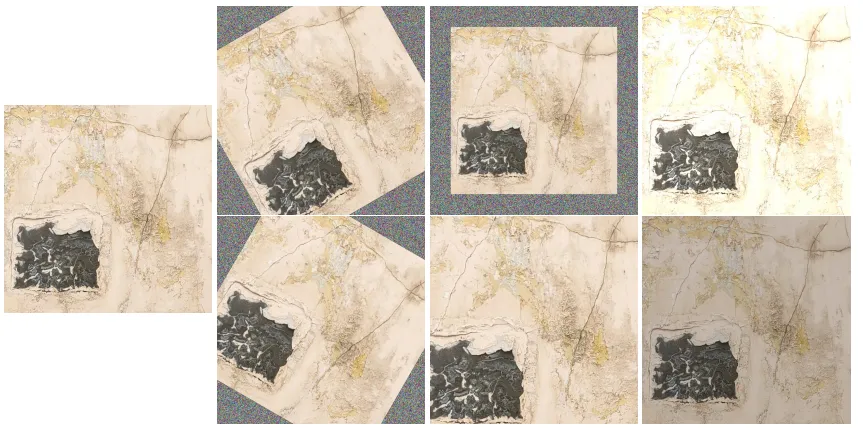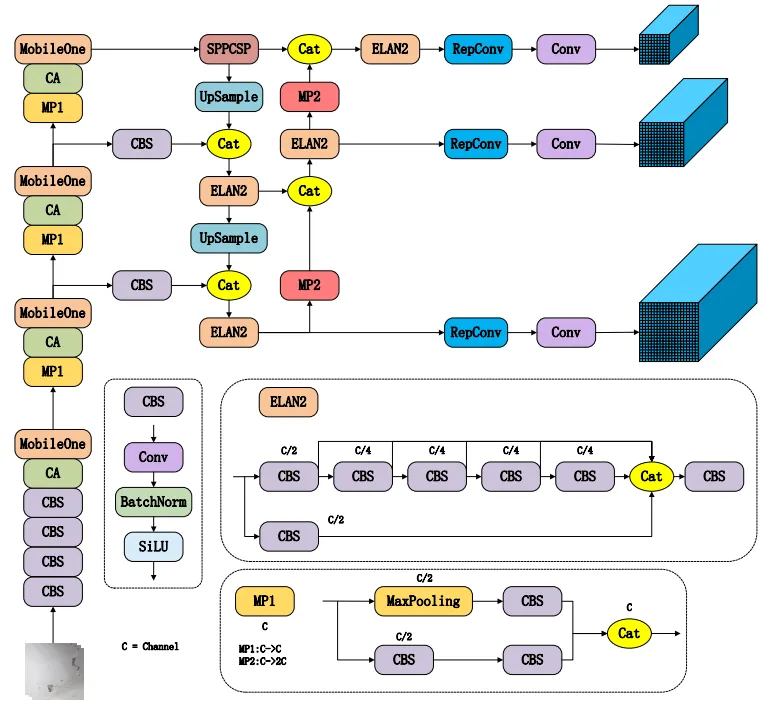
Current deep learning-based methods face some challenges in terms of recognition speed and model complexity. In order to ensure the accuracy and speed of building exterior wall defect detection, we studied an improved YOLOv7 method named BFD-YOLO. First, the original ELAN module in YOLOv7 is replaced by the lightweight MobileOne module to reduce the number of parameters and increase the inference speed. Secondly, a coordinate attention module is added to the model to enhance feature extraction capabilities. Next, SCYLLA-IoU is used to speed up detection and increase the recall of the model. Finally, we extended the open dataset and constructed a building facade damage dataset including three typical defects. BFD-YOLO demonstrates excellent accuracy and efficiency based on this dataset. Compared with YOLOv7, the accuracy and mAP@0.5 of BFD-YOLO are improved by 2.2% and 2.9% respectively, while maintaining considerable efficiency. Experiments show that this method achieves high detection accuracy while ensuring real-time performance.
The presence of facade defects is a pressing issue during the operational phase of construction and is often attributed to mechanical and environmental factor. Typical defects include concrete spalling, decorative spalling, component cracks, large-scale deformation, tile damage, moisture damage, etc. These defects can affect the appearance and reduce the service life of the building. As an integral part of structural damage detection, building exterior wall defect detection can enable governments and management to accurately understand the comprehensive condition of building exterior walls, thereby helping to formulate reasonable repair plans. This is crucial to reducing building maintenance costs and extending the service life of the building. As an integral part of structural damage detection, building exterior wall defect detection can enable governments and management to accurately understand the comprehensive condition of building exterior walls, thereby helping to formulate reasonable repair plans. This is crucial to reducing building maintenance costs and extending the service life of the building. Many countries and regions are developing policies for periodic standardized visual inspections. Detection of defects in building exterior walls has become an important part of building maintenance, which helps to accurately understand the comprehensive condition of building exterior walls, thereby helping to formulate reasonable repair plans. This is an important way to reduce building maintenance costs and extend the service life of the building. Many countries and regions are developing policies for periodic standardized visual inspections. Detection of defects in building exterior walls has become an important part of building maintenance, which helps to accurately understand the comprehensive condition of building exterior walls, thereby helping to formulate reasonable repair plans. This is an important way to reduce building maintenance costs and extend the service life of the building. Detection of defects in building exterior walls has become an important part of building maintenance, which helps to accurately understand the comprehensive condition of building exterior walls, thereby helping to formulate reasonable repair plans. This is an important way to reduce building maintenance costs and extend the service life of the building.
Visual inspection is a simple and reliable way to assess the condition of a building’s exterior. Traditional building exterior inspections typically require professionals to arrive at the inspection site armed with specialized tools, where they are evaluated using visual inspection, hammering and other techniques. These methods rely on the expertise and experience of the inspector, which is subjective, dangerous and inefficient. Due to the increase in the number and scale of buildings, manual visual inspection methods are no longer sufficient to meet the requirements for large-scale inspections. As technology advances, many new methods (such as laser scanning, 3D thermal imaging and SLAM) are being used for exterior wall damage detection via drones and robotic platforms. These new methods are more convenient and safer than traditional techniques, but are time-consuming and costly. Therefore, these methods also face challenges in meeting the needs of large-scale inspections. Therefore, it is necessary to develop a more accurate and effective surface defect detection method to improve detection efficiency and reduce computational costs.
There are many types of building exterior wall defects, and different detection methods are applicable. Common types include pullout defects, spalling and wall hollows. For cracks, there are more studies using semantic segmentation for detection. For wall hollows, the tapping method and infrared thermal imaging method are more widely used. After research and research, we selected defect types that are suitable for target detection methods and easy to construct data sets. The images in the data set mainly come from building facade images taken by mobile phones, cameras and drones. In addition, some images from the Internet and public datasets are also used for expansion. All images range in width from 1000 pixels to 3000 pixels. The height range is between 2000 pixels and 5000 pixels. The dataset consists of three building facade defects: delamination, spalling, and tile loss. A total of 1907 original images were collected, which contained background images of infrared thermal imaging images. Background images are defect-free images added to the dataset to reduce error locations. The training set, validation set and test set are divided in a ratio of 7:2:1. The image below shows an example of defects in the dataset.

From left to right are delamination, spalling and tile loss.
Data Augmentation
A large amount of data is often required in model training of neural networks. However, it is relatively difficult to obtain images of building facade defects, and there is a class imbalance problem in the collected data. To mitigate the impact of this problem, we apply data augmentation techniques to the training data. Data augmentation is a common technique for performing various transformations on raw data. It is widely used in the field of deep learning to generate more training data. Data augmentation can help the model learn more data variations and prevent it from being overly dependent on specific training samples. Surveillance data enhancement techniques include geometric transformations (e.g., flipping, rotating, scaling, cropping, etc.) and pixel transformations (e.g., noise, blur, brightness adjustment, saturation adjustment, etc.). The goal of data augmentation is to generate more training samples while preventing it from being overly dependent on a specific training sample. This can help the model better respond to changes in data and prevent overfitting. Data augmentation can help the model learn more data variations and prevent it from being overly dependent on specific training samples. For surveillance data enhancement techniques, various transformations (e.g., flipping, rotating, scaling, cropping, etc.) and pixel transformations (e.g., noise, blur, brightness adjustment, saturation adjustment, etc.) can be applied. These techniques can help the model better respond to changes in data and prevent overfitting. To make full use of data augmentation techniques, we can use different data transformations (such as flipping, rotating, scaling, cropping, etc.) and pixel transformations (such as noise, blur, brightness adjustment, saturation adjustment

##New design framework

04 Project implementation effect
An experimental platform is established for training. model and conduct testing. The hardware and software configuration of the experimental platform are as shown in the following table.
| System | Win 10 |
|
CPU |
I7- 11700 |
|
GPU |
##RTX 3090 |
|
| RAM | ##32GB||
|
|
||
|

The above is the detailed content of Smart Building: Building Exterior Wall Defect Detection Based on YOLOv7. For more information, please follow other related articles on the PHP Chinese website!




